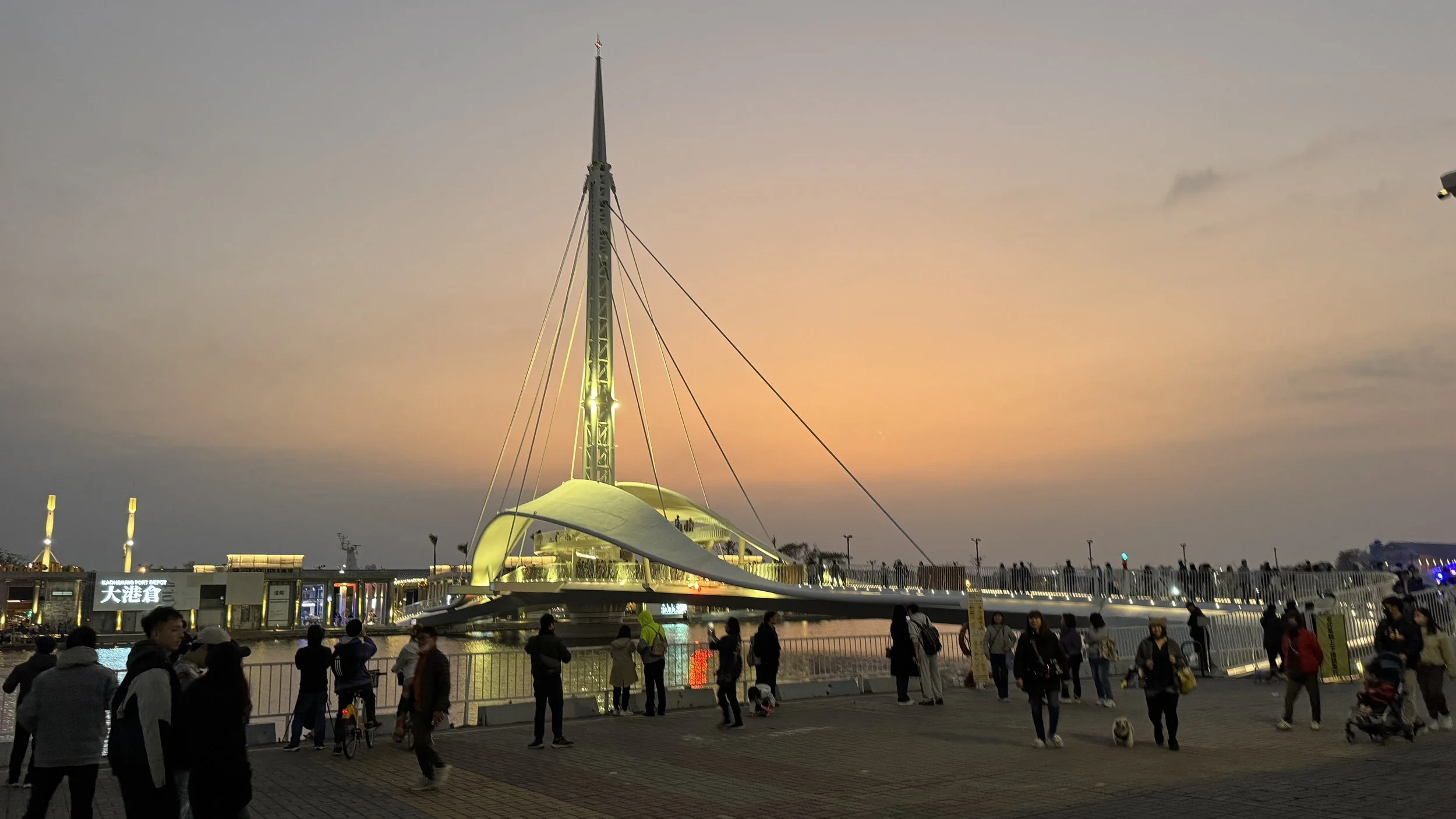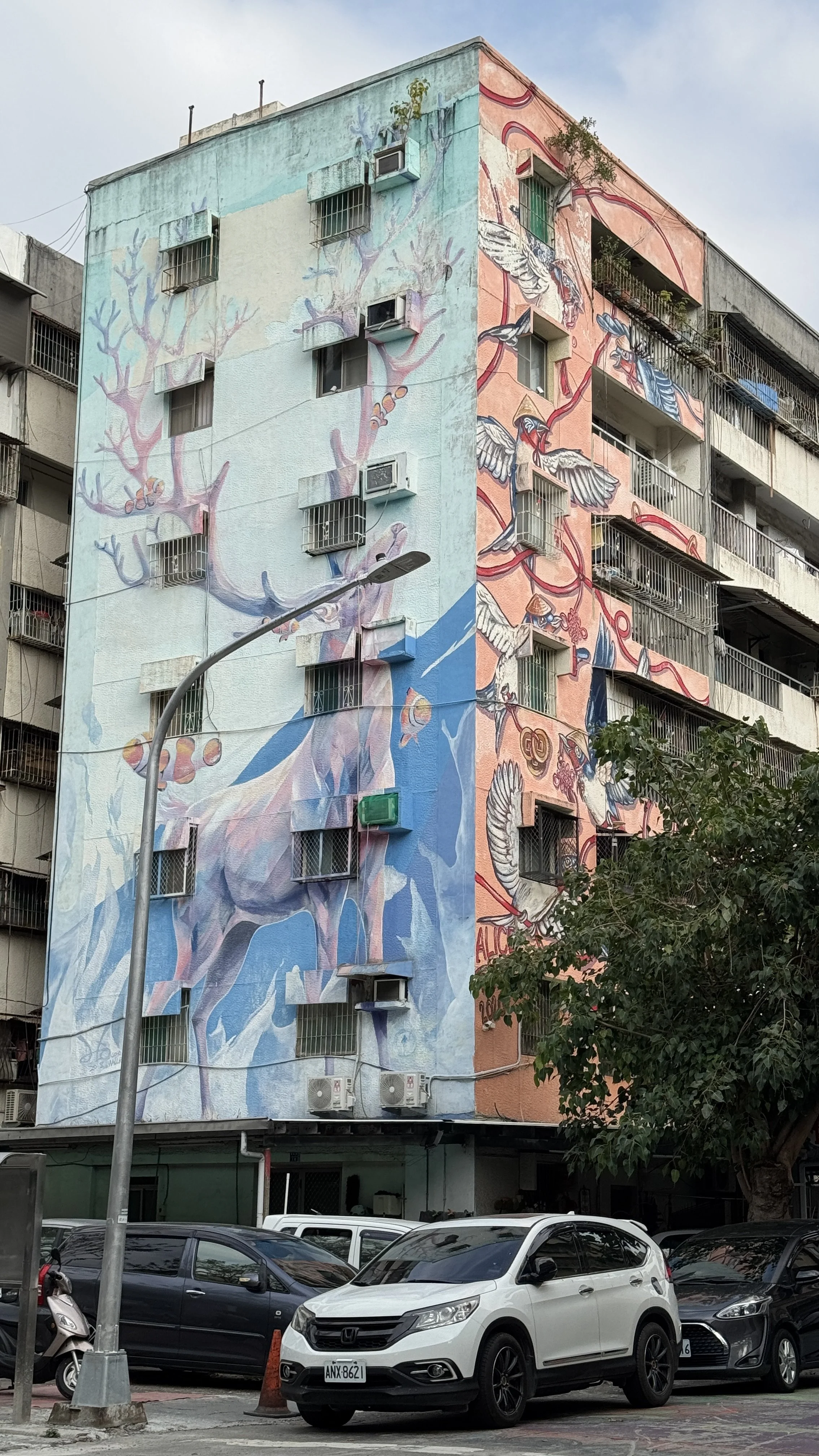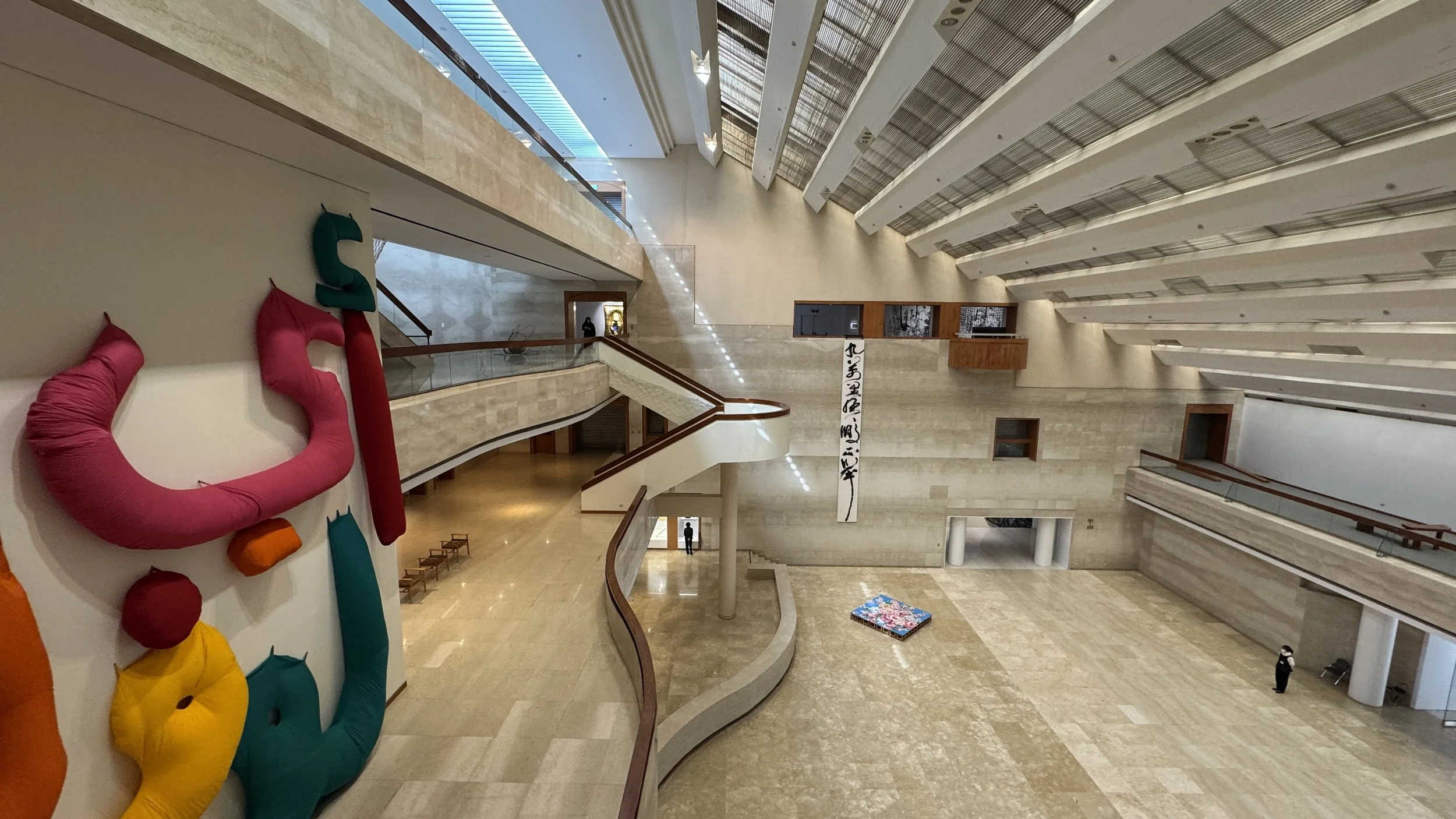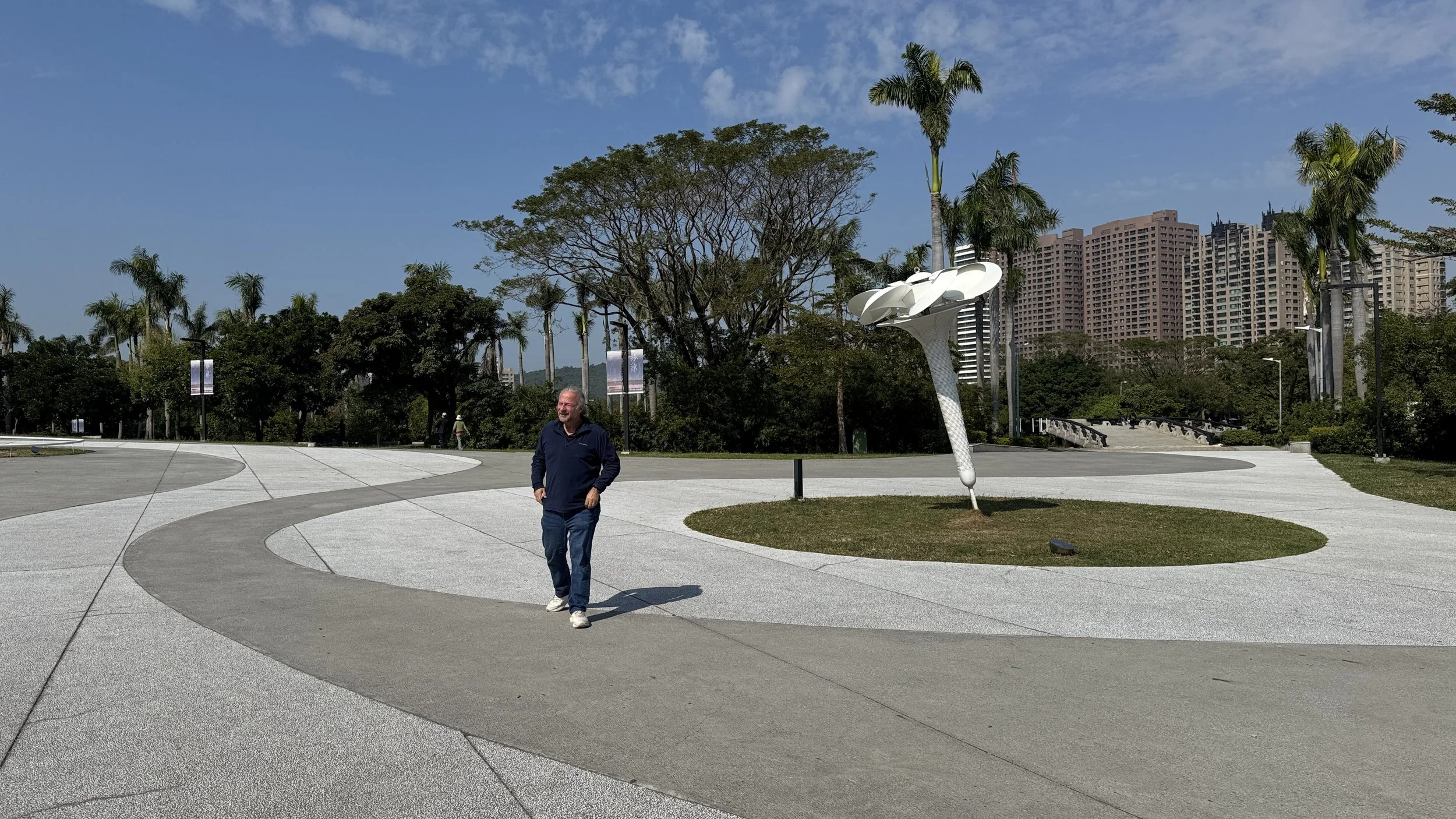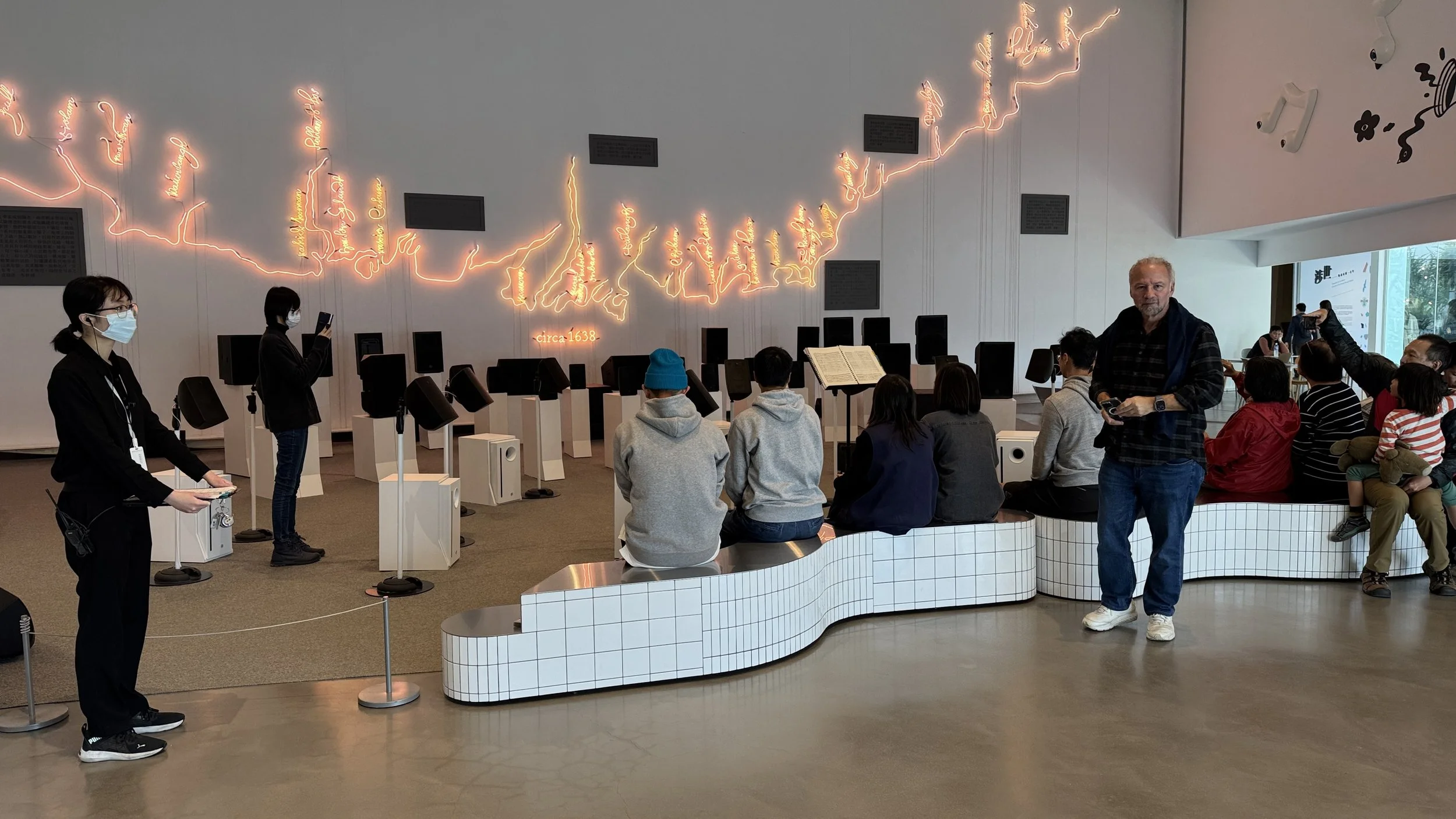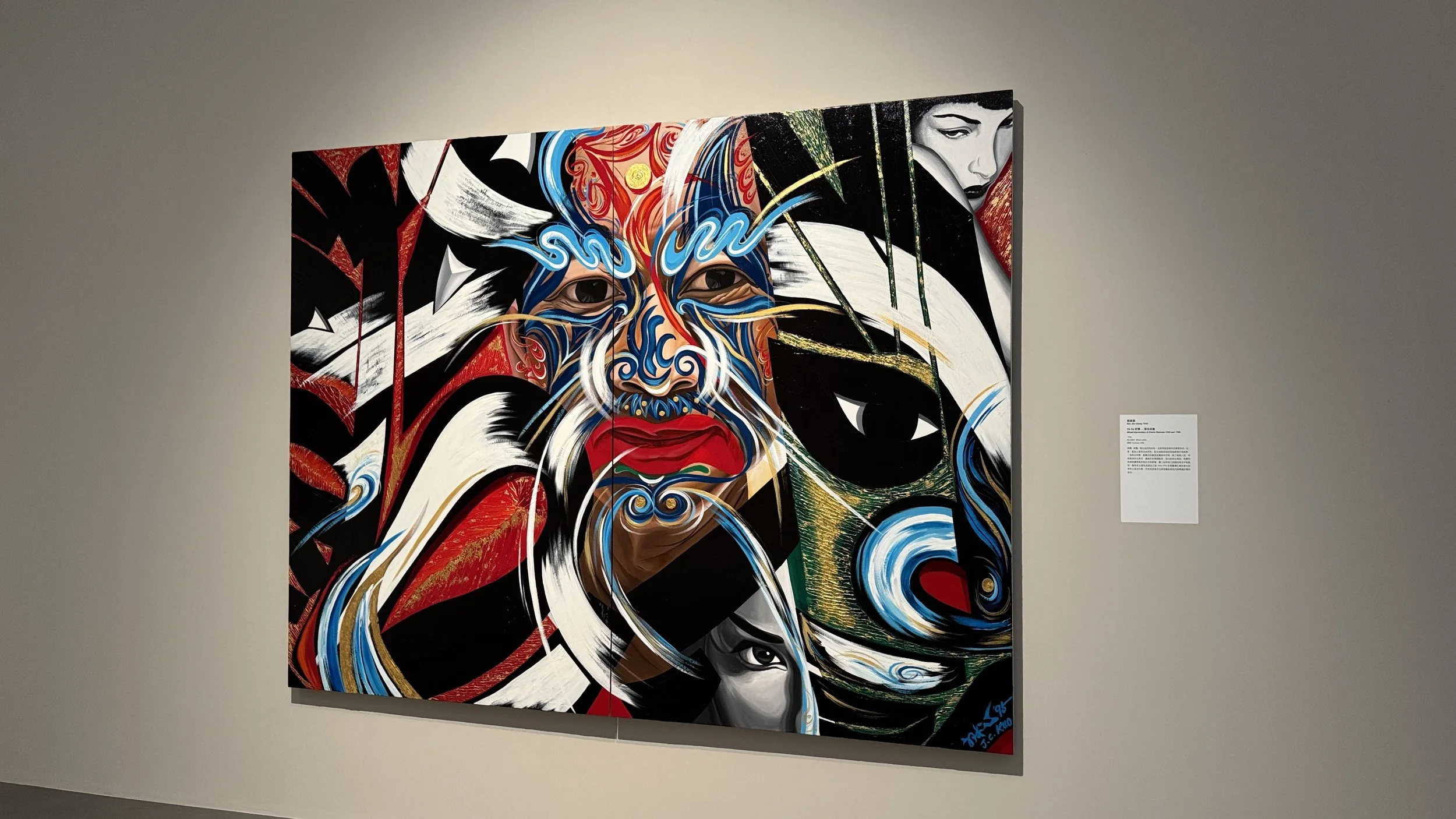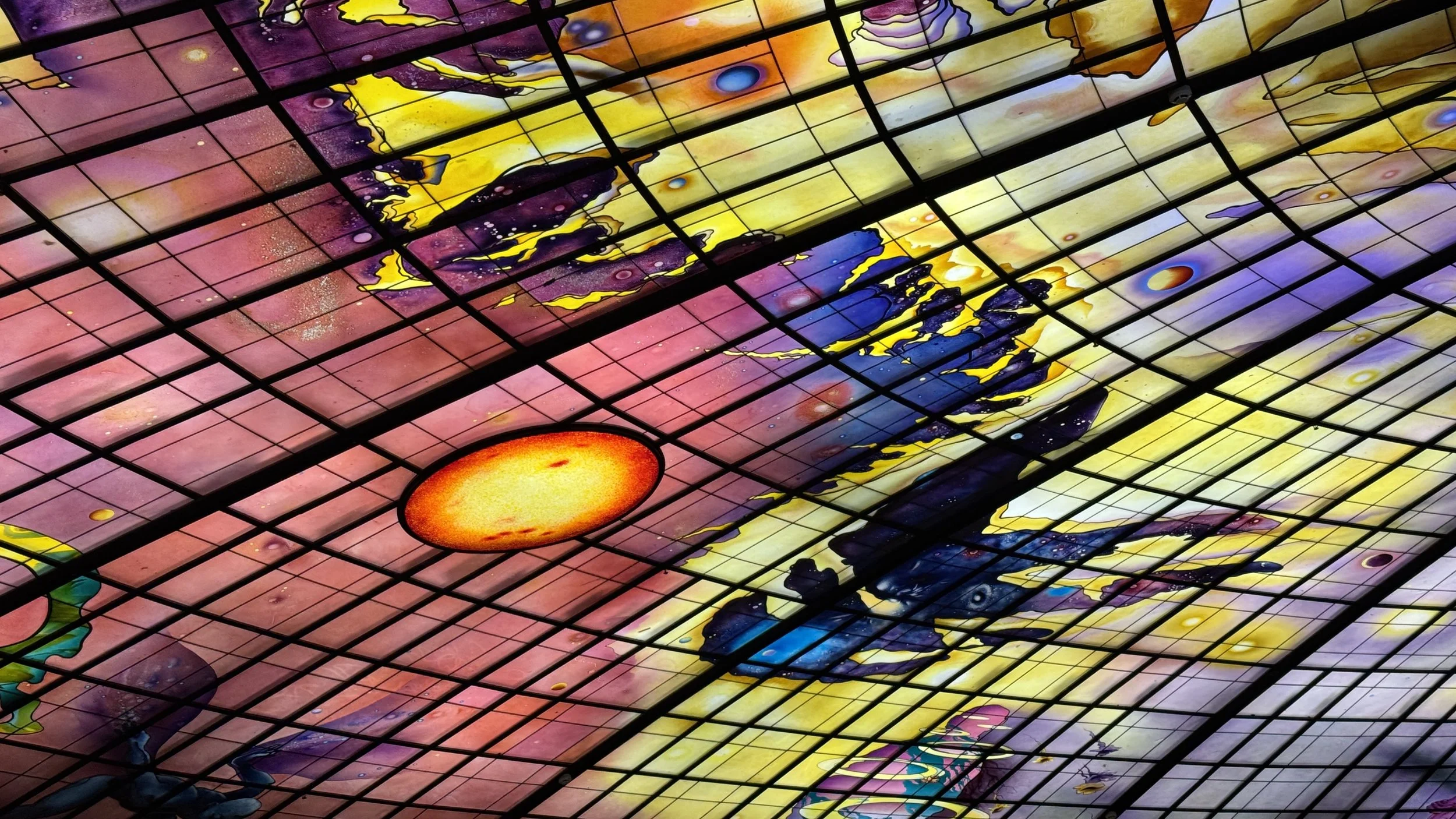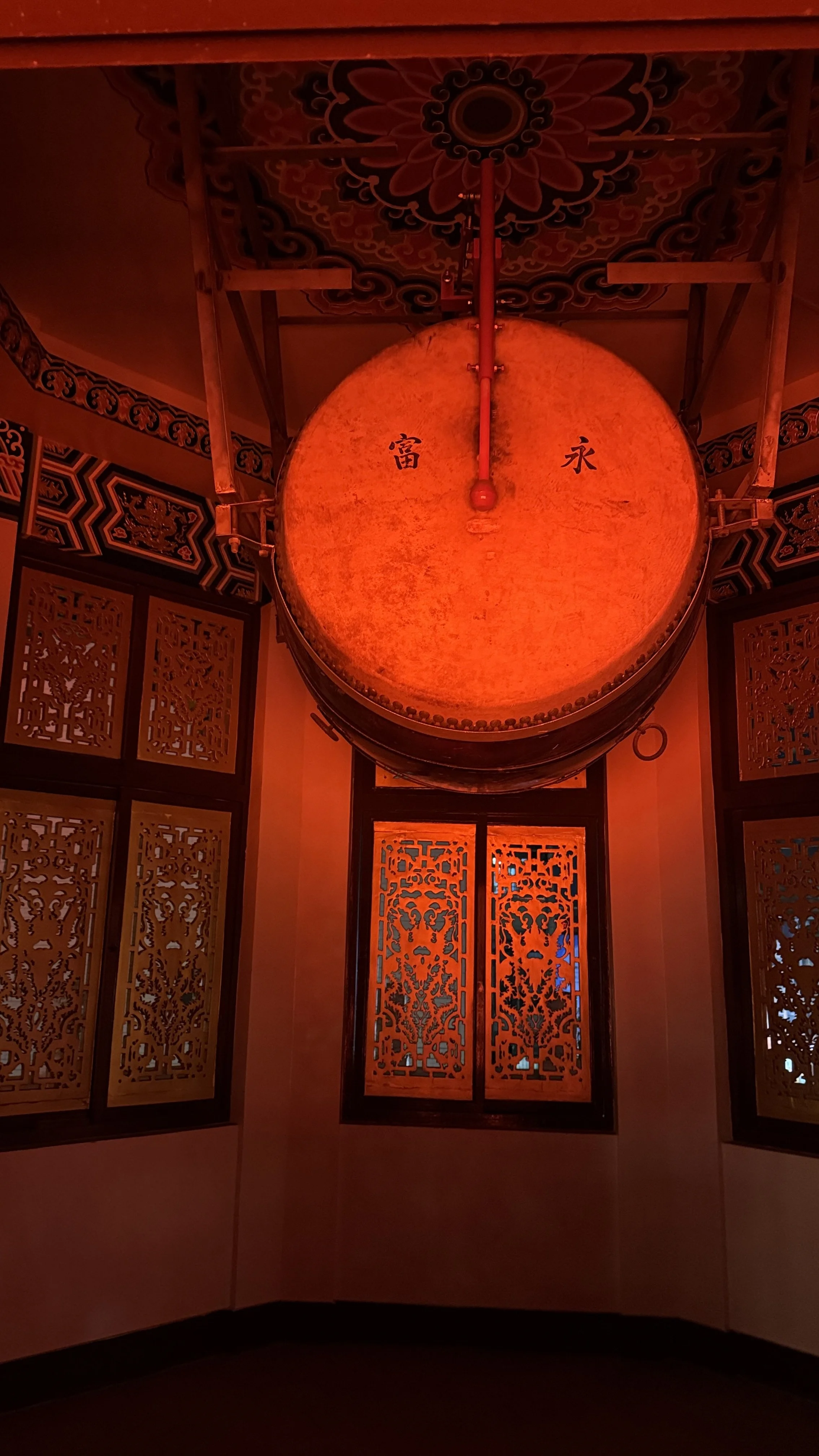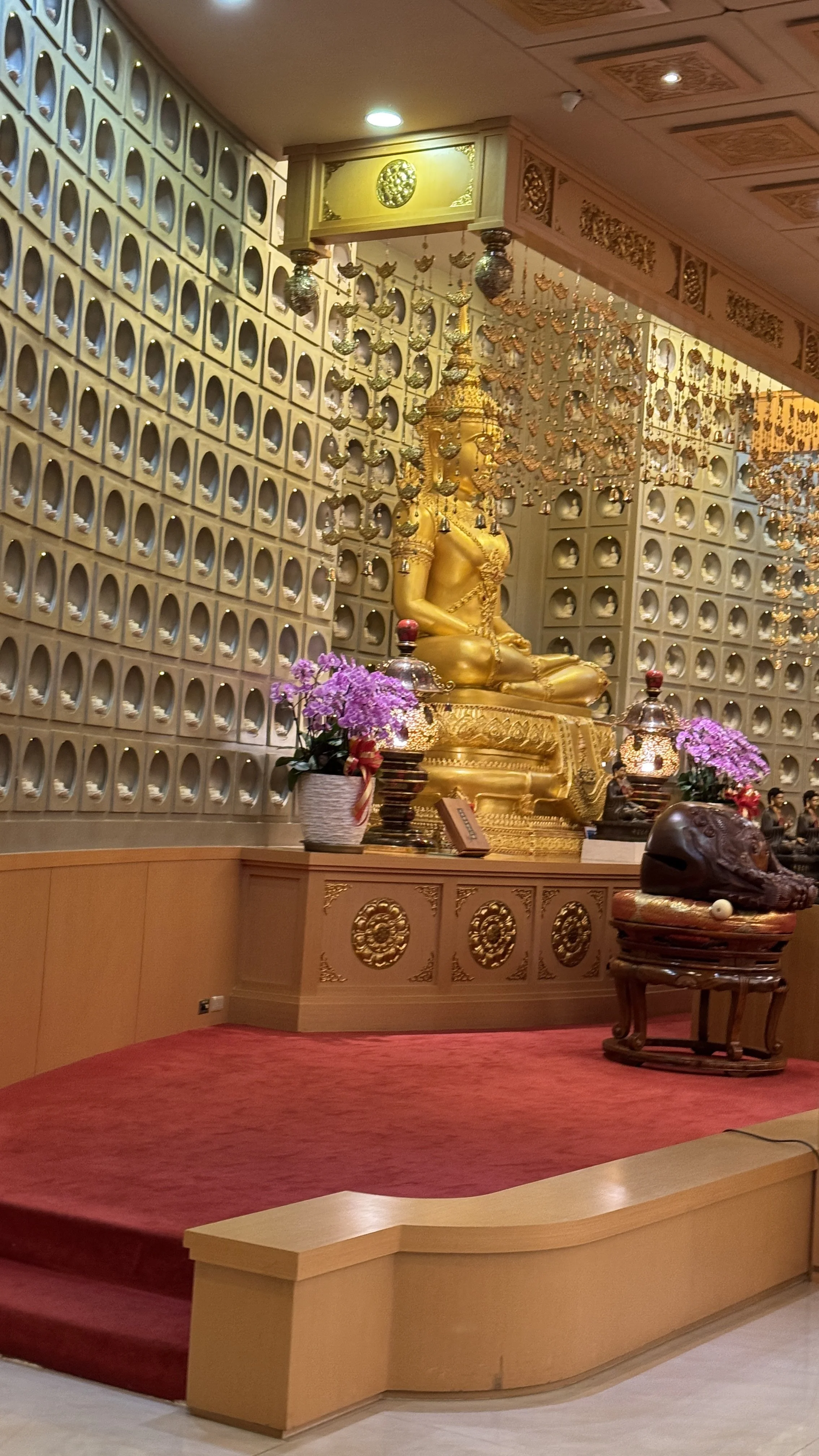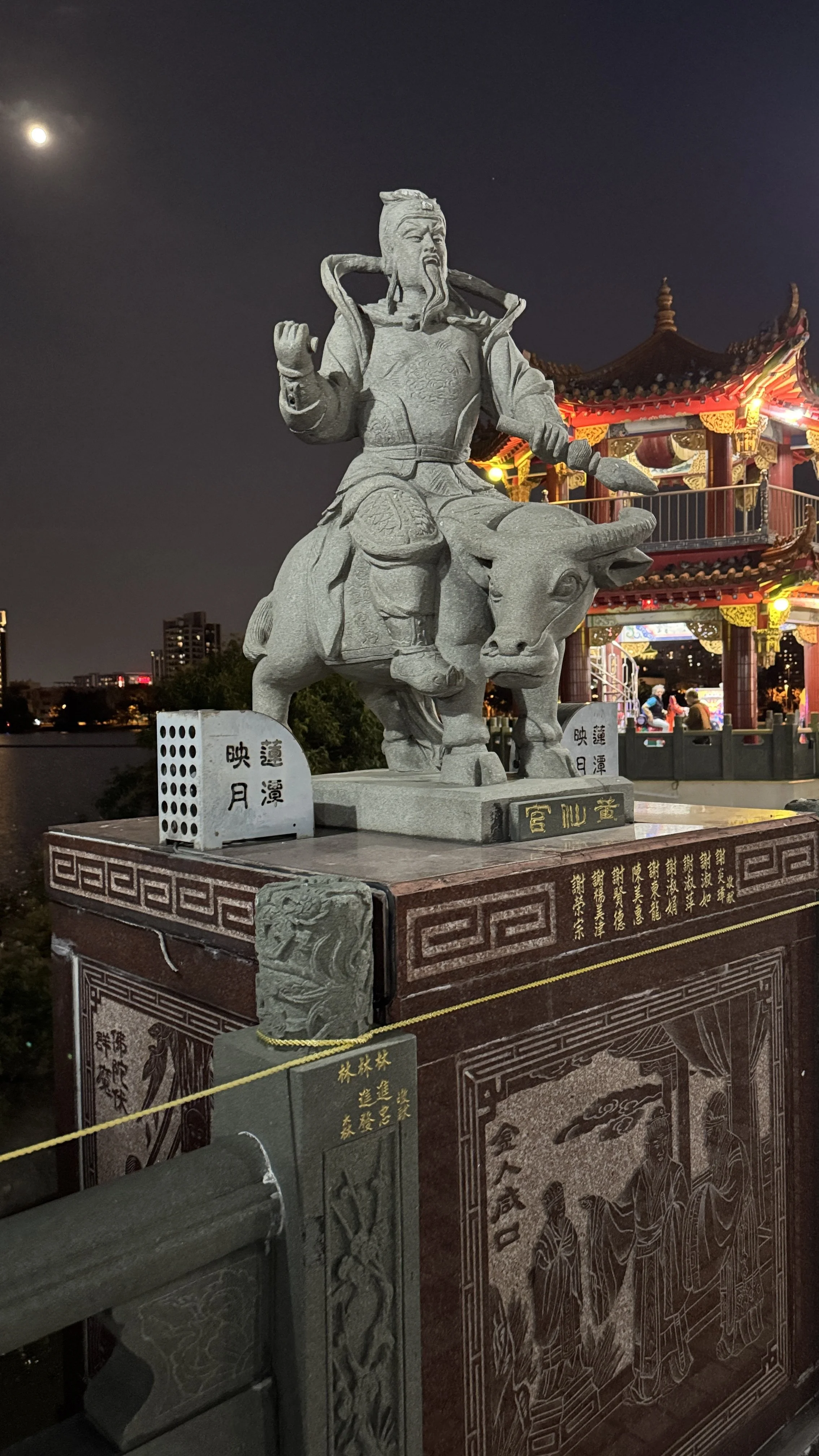Part II: Kaohsiung
Excited to board the High Speed Rail to Kaohsiung
The cream of the crop, the best for last, the trip that really excited us both was four days in Kaohsiung. Taking the famed high speed rail (HSR) from Taipei traveling at speeds reaching 300 mph (83 kph), we arrived a mere 90 minutes later at our destination. We took a taxi from Zuoying Train Station to our hotel in the Pier 2 district and surprisingly arrived with little issue. We were getting better at navigating taxi drivers who spoke no English.
Selfie from the Great Harbor Bridge with the music center in the background
The Great Harbor Bridge connects shopping areas
We chose to stay at the Pier-2 Art District because it was within walking distance to the Green line, a ring of 37 stations to the most interesting tourist destinations in the city. Locals conveniently used their pre-paid cards to enter a station, but tourists needed to buy tickets from a dispenser, and the dispenser only took coins. One time, I ran out of coins and had to ask a local woman if she could make change for me. She wouldn’t accept my money, but handed me the coins needed to board the train legally. And she welcomed us to Taiwan. We have only met lovely people on this island who have been very friendly and supportive.
Steps from our hotel, the Pier-2 Art district on the wharf (rows of buildings with stores, pubs, restaurants, coffee shops, and art installations) enthralled us. The Wharf area was steps from the Great Harbor Bridge, a stunningly designed pedestrian walkway leading to another bustling area of bars, restaurants, and shops. We would often walk there in the evening for drinks after a full day.
Four days in Kaohsiung is not nearly enough time to see everything the city has to offer, but we made a dent in the Things to Do list especially with the help of our dear friend Amy Lo who is from this city. She texted us an amazing list of secret haunts and coffee shops we should go out of our way to visit.
WeiWu MiMi Village is reminiscent of Rainbow village but on steroids. The street artwork spans apartment buildings and offices with paintings of whales, forests, or simple whimsy of much higher quality than Rainbow village in Taichung.
Our first mural really wowed us
Conceived by the local government and residents of the village as a way to revitalize and beautify the neighborhood, it is like nothing else I’ve experienced before. Walking along the streets, I gawked at the different styles and motifs and scenes.
We both just wandered through this wonderland of painted apartment buildings glad of the experience.
A fantastical beast
On the same day, we visited several museums. Kaohsiung Museum of Fine Arts bordered Neiwei Park and housed pieces by local Taiwanese artists. The installations were intriguing and the museum is still growing having received funding from the government over recent years. Still the huge building had a lot of space available for budding artists. Amy suggested we stroll through the park after visiting the museum and we did. The park borders a huge lake and is bursting with herons, ibises, and a flock of black-backed wagtails to name a few species we observed. The landscaping of the park is very feng shui.
Bordering the park, we stumbled on the Neiwei Arts Center, a free museum which highlighted the history of Taiwan and had other intriguing sculptures, including an orchestra of speakers. Each speaker played the recording of a single instrument with the entire ensemble perfectly synched to harmonize like a classical orchestra. We loved learning more about the origins of Taipei and the entire island in another exhibit at this museum.
The Science and Technology Museum, one of the largest in the world, was the final destination in our museum tour. We’d had a long day of walking by then, so we paused for a snack and coffee in the museum cafe before tackling some of the exhibits. Gitty will discuss some of this in a later post, but one exhibit on earthquakes in Taiwan caught our interest. They had an earthquake chamber where we experienced simulated quakes of magnitude 3, 5, and 7. The children in the room followed the instructions to find shelter and flocked beneath the single table bolted to the floor of the chamber, huddling together and pretending to be in the real deal, shrieks and all. It was delightful … and thankfully only a simulation.
Play acting or preparing
That was until a week later when a real magnitude 6 quake shook Kaohsiung. Back in Taipei, an earthquake alert popped up on our phones. It was past midnight and we were preparing for bed. We didn’t know what to make of it until our 23rd floor hotel room swayed beneath our feet for what felt like several minutes. It was an eerie experience feeling the solid floor shaking back and forth. One that neither of us previously experienced.
In Taipei, it registered as a magnitude 3 quake. We calmly dressed and packed some important things in our backpack in case the hotel called for an evacuation, but we got the all clear message over the room loudspeaker a few minutes later and went to bed.
Taiwan constructs their buildings to be quake proof using several different architectural techniques, and we were prepared and calm during the incident because of having visited the earthquake exhibit.
The Dome of Light is an art installation situated in Formosa Boulevard Station where the red and orange city train lines meet. Taking nearly four years to complete, this stunning light display tells the story of human life using water, earth, light and fire. Gitty smirked as I literally walked beneath the display looking around for signs of it. I could sense something was off as she wouldn’t budge when I waved her over. She just smiled and gazed upwards. I glanced up and froze. The majesty of the installation needed time to appreciate. We walked to the different sections of the dome analyzing the messages of compassion and tolerance depicted within the glass panels.
Afterwards, we visited Liuhe Night market, and the less said, the better. We got the feeling that the night markets here didn’t compare with those in Taipei, so forewent visiting more and jumped on some restaurant suggestions from Amy instead like the Old & New Taiwanese Cuisine Shiquan Branch, with a delightful Omakase menu.
We also felt like sushi, and the sushi here so close to Japan is fresh and inexpensive. Kura Sushi is highly recommended, specifically the flagship restaurant located off the Green Line Cianjhen Star station. Popping in without a reservation required a 45 minute wait, but we were assured it would be worth it, so we went … and we waited … and it was worth it, a sushi train experience unlike anything we previously encountered!
Everything was automated down to the payment system. Some of it confused us and the ordering tablet was initially set in Mandarin so we needed Google Translate if we wanted to order specialties from the kitchen which was delivered straight to your private booth on a second, super fast conveyor belt. And the green tea, which I initially thought was powdered wasabi (I sprinkled it on one of my sushi rolls) should have been spooned in a tea cup and hydrated by a spout of hot water. When you finished a plate, you slid the plate down a ramp which kept a tally of your choices and every five plates triggered a fun game on the tablet, which I didn’t understand, but tried to play anyway. There were two price points to the sushi. One plate or two plates. The tally of plates at the end signified the total cost of the meal, and after an hour and 16 plates, we barely broke $30 for dinner. We were still shocked at how cheap it was to dine out in the city, but that’s why everyone does it.
Wholesale goods in 10 kg bags are weighed and sold in smaller quantities to the patrons
San Fong Jhong Street is a covered wholesale shopping street containing huge bags of dried goods where locals can buy their spices, dried mushrooms, nuts, herbs, dried fruit and other Taiwanese necessities (mainly for the older generations opposite the younger ones that prefer to shop in supermarkets.) We had heard about it and were in the neighborhood, so we walked along the covered street while motorcycles scooted past us in that narrow center lane. Covered or not, it was still an active street. Although it was a struggle for us to find something to buy, we ultimately settled on a bag of dried mango slices.
We visited Sunfong Temple one evening.
Randy praying for peace on Earth
Night had fallen and the temple was mostly empty, but its beauty and uniqueness came through despite the cloak of darkness. The glowing red lantern array in the entry hall lit up both the drum and bell towers common to many Taoist temples in Asia. The many halls contained statues of deities and colorful decorations enchanting us. Some locals to whom this space held sacred significance knelt and prayed to the deities.
One sunny day, I made the long 50 minute trek by taxi to the Fo Guang Shan Buddha Museum and Monastery, listed as one of the important destinations in the area.
The Golden Buddha towers above the museum
The complex houses rows of colorful pagodas bordering a central square leading up to the Buddha museum and a 120 foot (40 m) statue of the sitting Golden Buddha. The museum housed artifacts from the 6th century including 1000 year old chopsticks that looked as good as new. The sun shone brightly and the afternoon couldn’t have been more pleasant.
We had heard that the Tiger and Dragon Pagodas at Lotus Pond were still under renovation and not to bother visiting the pond, but Amy came to the rescue and learned from a friend that the renovation was complete. She said we should check it out.
View of the Tiger and Dragon Pagodas and us
So, following her sage advice, we arrived at the lake around sunset and wandered around the shoreline for an hour as the sky darkened and the pavilions and pagodas lit up in the evening twilight. We enjoyed a relaxing stroll on the paths along the water’s edge. It was our last night in Kaohsiung and what a lovely way to spend it.
The thing is, we have only visited a small corner of the majestic treasures Taiwan has to offer. We haven’t visited Tainan, the island’s capital during the Qing Dynasty. We haven’t visited the eastern coastal area, which many consider the most beautiful part of the island, and we haven’t visited the central mountains where tea plantations dot the landscape. There is so much to see on this relatively small island country that we will have to return again some day.
新年快乐 / Xīnnián kuàilè / Happy New Year


